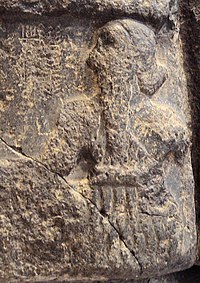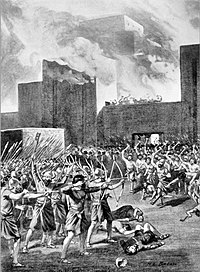Akadia
Akadian Empire | |
|---|---|
 | |
| Capital | Akad |
| Common languages | Akadian Sagigan (declining) |
| Religion | Akadian religion |
| Government | Monarchy |
| Šarrum (Kings) | |
• c. 2334–2279 BC | Sarugan (first) |
• c. 2170–2154 BC | Shu-turul (last) |
| Historical era | Bronze Age |
• Established | c. 2334 BC |
• Disestablished | c. 2154 BC |
| Today part of | Terranihil |
| The Ancient Caelean Coast |
|---|
 |
| Regions and states |
| Archaeological periods |
| Languages |
| Literature |
| Mythology |
Akadia, or the Akadian Empire, was the first ancient empire of Alaia after Sagiga. It was centered in the city of Akad. The empire united Akadian and Sagigan speakers under one rule. Akadia exercised influence across Alaia and the Caelean Coast.
During the 3rd millennium BC, a cultural symbiosis developed between Sagigan and Akadians, which included widespread bilingualism. Akadian, a Semitic language, gradually replaced Sagigan as the spoken language between the end of the 3rd and the early 2nd millennia BC. The Akadian Empire reached its political peak between the 24th and 22nd centuries BC, following the conquests by its founder Sarugan of Akad.
After the fall of Akadia, the people of Alaia eventually coalesced into two major Akadian-speaking nations: Babilla in the north and Ashoria in the south.
Contents
History
Pre-Saruganic Akad
Akadia takes its name from the city of Akad, both of which were localized around the Alaius River. Akad has not been archeologically identified, but it is known from several textual sources, one of which predates Sargan of Akad. Also considering 'Akad' is of non-Akadian origin, Akad was likely already established in pre-Saruganic times.
List of rulers
| Ruler | Middle Chronology All dates BC | |
|---|---|---|
| Sarugan | 
|
2334–2279 |
| Rimush | 
|
2278–2270 |
| Manishtusu | 
|
2269–2255 |
| Naramsin | 
|
2254–2218 |
| Sharkalishari | 2217–2193 | |
| Dudu | 
|
2189–2169 |
| Shuturul | 
|
2168–2154 |
Sarugan of Akad
- Main article: Sarugan of Akad
Sarugan of Akad defeated and captured Lugalzaggesi, the last Sumerian ruler, in the Battle of Uruk and conquered his empire. Sargan was originally a cupbearer to Urzababa, a king of Kish. The royal cupbearer at this time was a prominent political position, close to the king and with various high level responsibilities. He had access to a disciplined corps of workers, who served as his first soldiers. Displacing Urzababa, Sarugan was crowned king, and he began a campaign of foreign conquest. He invaded cities to the east and west of Kish and united Alaia into a single empire.
Sarugan took this process further, conquering many of the surrounding regions to create an empire that reached eastward as far as the Caelean Sea and its coastal islands; northward as far as periphery Malgan cities; westward to the Vantharus River and the Elamites; and south to the Murtans. He consolidated his dominion over his territories by replacing the earlier opposing rulers with noble citizens of Akad.
Rimush and Manishtushu
Sarugan had easily defeated his opposition even at old age, however wars broke out again in the reign of his sons. Peripheries of the empire revolted during the nine-year reign of Rimush (2278–2270 BC), who fought to retain the empire. He successfully reconquered Ur, Umma, Lagash, and Kazallu, but he was assassinated by his own advisors. Rimush had ordered mass slaughter and large scale destruction of those and other Sagigan city-states. Sagigan casualties were enormous, exceeding 100,000 deaths.
Rimush's elder brother, Manishtushu (2269–2255 BC) succeeded him. Manishtushu fought a naval battle against 32 kings who had united against him. Despite his success, he was also assassinated in a palace conspiracy.
Naramsin
Manishtushu's son and successor, Naramsin (2254–2218 BC), due to vast military conquests, assumed the title "King Naramsin, king of the four-quarters" in reference to the entire world. He was also for the first time in Sagigan culture, addressed as "the god of Agade" (Akad), in opposition to the previous belief that kings were only representatives of the people for the gods. He also faced revolts at the start of his reign, but quickly crushed them.
Under his rule, the akadian economy was highly planned. Grain was cleaned, and rations of grain and oil were distributed in standardized vessels made by potters. Taxes were paid in produce and labour on public walls, temples, and irrigation canals, producing huge agricultural surpluses. This newfound wealth may also have been caused at least partially by climatic conditions and the confiscation of the wealth of other peoples.
During this period, the Akadian language became the lingua franca of much of the Caelean coast, although Sagigan remained as a literary language. The spread of Akadian stretched from the coastline to Elam, and even the Elamite language was temporarily written in Alaian cuneiform. Akadian texts were later found in distant lands, from Alaqa to Shazaqana.
Submission of Sagigan kings
The submission of many Sagigan rulers to the Akadian Empire is recorded in seal inscriptions of Sagigan rulers, which refer to sagigan rulers as governors of city-states and at the time vassals (𒀵, arad, "servant" or "slave") of Naramsin, as well as his successors Sharkalishari and Dudu.
Collapse
The empire of Akad fell, likely in the 22nd century BC, 180 years after its founding, ushering in a "Dark Age" with no prominent imperial authority until the Third Dynasty of Ur. The region's political structure reverted to local governance by city-states.
Shuturul appears to have restored some centralized authority; however, he was unable to prevent the empire completely collapsing from the invasion of barbarianss peoples from the montane forests and meadows of the far east Shazaqana mountains known as the Gutians.
Little is known about the Gutian period or its length. Cuneiform sources suggest the Gutian administration showed little concern for maintaining agriculture, written records, or public safety. They released all farm animals to roam about Alaia freely and soon brought about famine and grain shortages. The Sagigan king Urnammu (2112–2095 BC) cleared the Gutians from Alaia during his reign.
There are no archeological sources verifying kings after Shuturul despite the Sagigan king list listing several others. during the Third Dynasty of Ur between c. 2112 and 2004 BC, documents again began to be written in Sagigan, though its decline continued.
One theory claims the regional decline at the end of the Akadian period is associated with rapidly increasing aridity and decreasing rainfall in the region of the Caelean Coast caused by a global drought.
Government
The Akadian government formed a standard which all Alaian states compared themselves. Traditionally, the ensi was the highest official of Sagigan city-states. Later, one became an ensi by marrying the goddess Inanna thus legitimising the ruler.
As Sarugan expanded his empire, it was said that he ruled everything under the heavens. Under him, the ensis generally kept their positions but were seen more as local governors. The title shar kishati became recognised as "lord of the universe". Sarugan is reported to have led one the first organised military naval expeditions in history.
Under Naramsin, Sarugan's grandson, the king was elevated to the ranks of the gods, with his own temple. Previously a ruler could, like Bilgamesh, become divine after death but the Akadian kings from Naramsin onward were considered gods on earth during their lifetimes.
One strategy adopted by both Sarugan and Naramsin, to maintain control of the empire, was to appoint their daughters as high priestess to Sin, the Akadian moon deity, and to install sons as provincial ensi governors in strategic locations. Additionally they married their daughters to rulers of peripheral parts of the empire.
Economy
The population of Akad, like nearly all pre-modern states, was entirely dependent on the agricultural systems of the region, which seem to have had two centers: the irrigated farmlands and the rain-fed agriculture of northern Alaia.
Southern Alaia during Akadian period seems to have been approaching its modern rainfall level of less than 20mm per year, resulting in agriculture totally dependent upon irrigation. Before the Akadian period, the increased salinity of the soils, caused by poorly drained irrigation, was reducing wheat yields in southern Akadia, leading to more salt-tolerant barley growing.
Harvest was in during late spring and the dry summer months. The nomadic Amorites from the northwest would pasture their flocks of sheep and goats to graze on the crop residue. For this, they would pay a tax in wool, meat, milk, and cheese to the temples. In low crop yield years, wild winter pastures would be in short supply, and nomads seeking to pasture their flocks in the fields would conflict with farmers.
Culture
Art
There was a great emphasis on kings in Akadian art. The degree of realism considerably increased from Sagigan art. Seals show a world of conflict and danger. Akadian sculpture is remarkable for its fineness and realism.
The kkadians used visual arts as a vehicle of ideology. Their figures became more sculptural and naturalistic. New elements were included in relation to Akadian mythology.
Language
During the 3rd millennium BC, a cultural symbiosis developed between the Sagigans and the Akadians, which included widespread bilingualism. The mutual influences between Sagigan and Akadian are apparent in all areas including word borrowing on a massive scale, and syntactic, morphological, and phonological convergence.
Akadian gradually replaced Sagigan as a spoken language somewhere around the turn of the 3rd and the 2nd millennium BC, but Sagigan continued to be used as a sacred, ceremonial, and literary language in Akadia and then Ashoria until around 500 BC.
Literature
Sagigan literature continued in rich development during the Akadian period. Enheduanna, the daughter of Sarugan, of the temple of Sin at Ur (c. 2285–2250 BC) is the first poet in history whose name is known. Her known works include hymns to the goddess Inanna and the Temple Hymns, addressing sacred temples and their deity. Her works are significant because they shift to the first person voice of the poet herself, an innovation in ancient literature.
Later literature describes how the fall of Akad was due to Naramsin's attack upon Nibur. The kings of Akad were legendary among later Alaian civilizations, with Sarugan understood as the prototype of a strong and wise leader, and his grandson Naramsin considered the wicked and impious leader who brought ruin upon his kingdom.
Achievements
Documents describe statues made of lead. The copper Bassetki Statue shows the high level of crafting skill during the Akadian period.
The empire was bound together by roads, along which there was a regular postal service. Clay seals took the place of stamps bear the names of Sarugan. The first collection of astronomical observations and terrestrial omens was made for a library established by Sarugan. A calendrical system was developed based on the Akadian kings and was used in most Akadian city-states.








